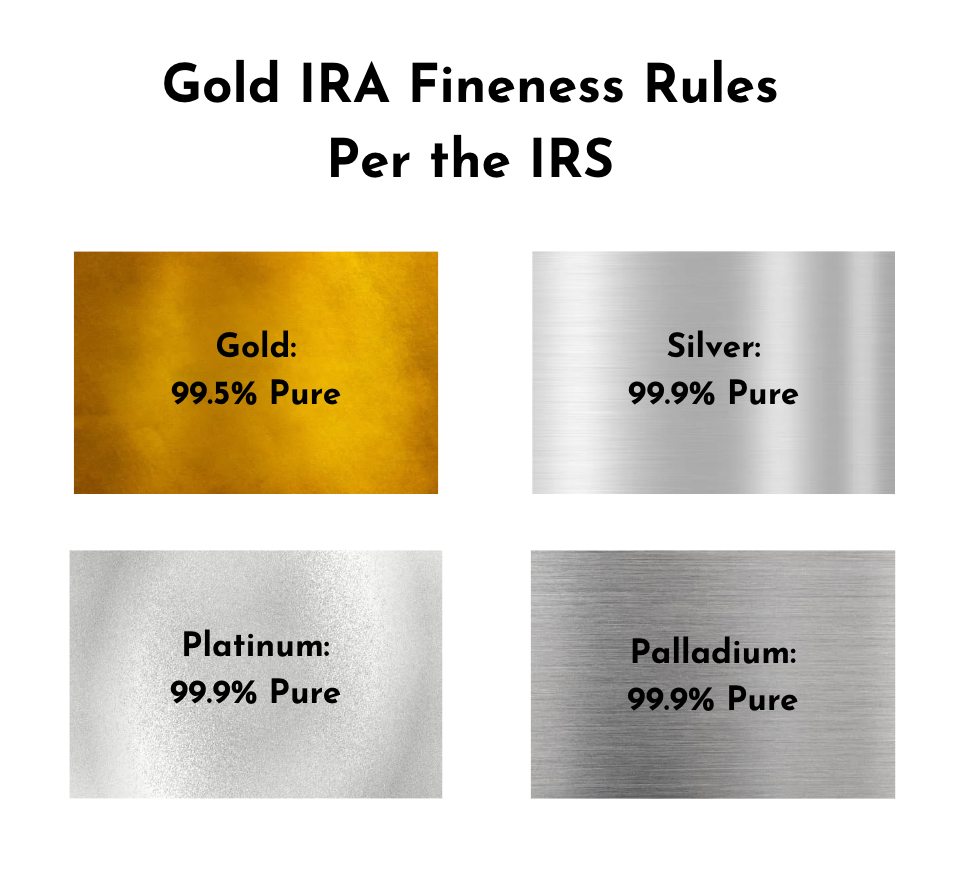How to Complete a 401k to Gold IRA Rollover
For those who are getting closer to retirement age, you might be thinking about how you will live off of your retirement savings once you stop working. You might have a 401(k) or a traditional or Roth IRA, but is this really the type of retirement account you want?
Another option is a tangible asset like precious metals. Gold has, for centuries, been a safe-haven investment, and this is especially true during times of economic uncertainty and a volatile market.
We can see that this is true by looking back in history. Even in relatively modern times, which many retirees might remember, gold has been fairly safe when compared to cash or the stock market. For instance, in the 1970s, which had a lot of inflation, gold prices rose extremely quickly. It started under $300 an ounce in 1970, and by January of 1980, it was $2,700 per ounce.
We can also look back at 2008 when the economy was hit by a financial crisis known as the Great Recession. When this happened, the S&P 500 plummeted. However, gold held strong. Not only did it not lose its value, but it actually gained.
Because we can see this happen right before our eyes, more investors than ever before are choosing to rollover or transfer funds from a 401(k) to a gold IRA account. This can help to keep your retirement funds safer, and it can also help to diversify your investment portfolio and reduce the risk of putting all your eggs in one basket – namely, in paper assets like stocks and bonds.
You can’t, in most cases, invest in physical gold if you have a 401(k). This means that if you want to make gold investments for retirement, you need to roll over your 401(k) funds directly into a precious metals IRA.
This might sound complicated, but with the help of a reputable gold IRA company, it doesn’t have to be. In fact, it can be very simple when you work with the right company and follow this guide.

What is a Gold IRA? Understanding a Gold IRA Transfer
It’s likely that you know what IRA investments are. At a basic level, they are a type of account that allows you to save for retirement. There are many benefits to this type of tax advantaged retirement account, and it can be an advantageous retirement strategy. (A financial advisor can give you more information).
A gold IRA is a type of IRA that allows an investor to hold physical gold, silver, platinum, and palladium in their portfolio. Unlike a typical IRA, which is limited to paper assets like stocks, bonds, and mutual funds, a gold IRA is a way to have a more diversified portfolio for retirement.
Though these accounts are known as “gold IRAs,” this is really a bit of a misnomer. These accounts are technically called “self-directed IRAs,” or SDIRAs. This allows the investor to choose the investments they add to their IRAs. In the case of a gold IRA, you purchase gold. This gold is held in a very secure storage facility, known as a depository, until you are ready to retire. Then when you are ready to retire, the gold in your individual retirement account can be withdrawn for you to live on.

Considerations Before Completing a Rollover from a Workplace Retirement Plan to a Gold IRA
There are a few things to keep in mind before you rollover a 401(k) into a gold IRA. The rollover is easiest if your 401(k) is with a former employer. Why? Because most 401(k) plans don’t allow you to remove the funds from the account while you are still employed, unless you are still working AND you are of retirement age.
However, some 401(k) plans do have something called an “in-service withdrawal.” This allows you to roll over the funds to an IRA when you are still working with your employer. Keep in mind that you still might have to be 59 1/2 to qualify for this.
If your 401(k) is not with a former employer, you can still start smaller and fund a gold IRA with cash. Depending on your chosen gold IRA company, the minimum amount may vary, as may the advice you are getting based on factors like your risk tolerance.

Direct Rollover vs Indirect Rollover
Once you know if you can rollover your retirement funds, you will need to start the rollover process so that you can transfer funds from your 401(k) to your new IRA. Keep in mind that your gold IRA custodian, who will be managing your account, often does this for you. There are, however, two main types of rollovers you can choose from: a direct rollover or an indirect rollover:
Direct Rollover
In a direct rollover, the funds are taken directly from your 401(k) plan to your new self-directed gold IRA. You will never take possession of the money. Because of this, there are no taxes or penalties that you have to think about. This type of IRA contribution is very straightforward and it minimizes the risk of errors.
Indirect Rollover
An indirect rollover is a bit different. In this case, the funds from the 401(k) are given to you, and then you are responsible for depositing then into the self-directed IRA account within 60 days. However, a lot of things could go wrong. If you do not put the money into your new IRA account, the IRS will consider it a withdrawal, which is subject to a 20% federal tax withholding. There may be other penalties too, as well as other tax implications. (If the financial institution you are using made a mistake, this would be waived for you.) Sometimes people also do not deposit the full amount into their new gold IRA, and this, too, could have implications.
It’s best to choose a direct rollover if you are transferring funds from a 401(k) to a gold IRA. If you already have an existing IRA, the process is similar, though it’s called a transfer, not a rollover.

The 7 Steps to Roll Over Your 401(k) to a Gold IRA (SDIRA)
Again, in many cases, your new gold IRA custodian will help facilitate this entire process. However, it’s always a good idea to understand what happens. Here is a step by step guide to help you understand the process of rolling over funds from a 401(k) to a gold IRA:
Step #1 – Open a Self-Directed IRA
You will need to choose a reputable custodian in order to start the process. There are many custodians and gold IRA companies out there, and trying to find the right custodian may be a process in itself. You definitely should take some time to compare companies. Specifically, you should look at customer reviews, fees, minimum investments, and what you want out of your investment strategy. Generally, the company you choose will help you with this process as mentioned above. Opening the account usually only takes a couple of minutes.
Step #2 – Fund Your IRS Through Your Chosen Gold IRA Custodian
Depending on your custodian, you will have the choice to do a direct rollover or an indirect rollover to get the funds from your 401(k) to your new gold IRA. Keep in mind that many companies offer different types of gold IRAs. You can choose a traditional IRA, of course, or you can choose a Roth gold IRA or a SEP IRA, which is an IRA for self-employed individuals.
Your custodian should explain their process to you, but generally they are similar. They will work directly with your 401(k) plan administrator to initiate the process. There may be a number of forms to fill out, and you will have to consent to different transfers. In general, there are no fees to transfer IRA funds, but again, this should be explained upfront. This is another reason why it’s so important to choose a gold IRA company and custodian that is well-reviewed and reputable. To rollover funds, all of the paperwork must be filled out correctly.
Step #3 – Choose Your Precious Metals Dealer/Gold IRA Company
In general, if you are working with a custodian, you have already chosen a gold IRA company. However, people do this in different ways and with different steps. Many people choose a gold IRA company first, and then they have the choice of one or two custodians and one or two depositories. Alternatively, some gold IRA companies allow you to choose any custodian or any IRS-approved depository. Before choosing your IRA company, you need to think about security, insurance, and fees associated with the depository and custodian. Again, there are also account minimums to consider. Typically, these go from $10,000 to $50,000, but this varies.
Here’s our list of the top choices:
- Augusta Precious Metals ($50,000 investment or more)
- Goldco (No investment minimum & potential for free silver)
- American Hartford Gold ($10,000 minimum)
There are other firms, lesser rated by our staff, including Lear Capital and the Fidelity Gold IRA. Your investment needs are unique to your own goals, so do a lot of research.
Step #4 – Buy Your Metals
The last major step is to buy the metals to hold in your IRA. You can choose gold or other precious metals, but keep in mind that these must be IRS-approved precious metals. The IRS has specific rules for which physical precious metals you can add to your IRA. For instance, not all gold coins are eligible. Collectibles, though they might be worth a lot of money, cannot be IRA assets per IRS rules. If you are confused, you can talk to your current IRA provider. They will help you add gold and other metals that are appropriate.
Step #5 – Store Your Metals
Once you have purchased your gold coins, gold bullion, or other precious metals, the company you work with will ship your metals to your chosen depository. Many gold IRA companies pay for shipping and insurance, but not all of them do, so make sure to check out the transfer fees before you buy. Also, storage fees may come into play. Some companies have a flat fee; others base the fee on the value of the metals in the account.

More information about the rules is found below:
Gold IRA Rules to Remember
Before you buy gold for your self directed IRA, you must remember that there are IRS rules that you have to follow in order to avoid tax penalties and make sure you aren’t taking a taxable distribution or taxable withdrawal unintentionally.
Eligible Metals for Precious Metals IRAs
When you do a 401k to gold IRA rollover, and you have money in your account to buy metals, you can only purchase certain ones. Here are the IRS rules on gold, silver, platinum, and palladium:

There are a couple of exceptions, though, like American Gold Eagles, which are 91.67% fine. The same rules apply to coins, bullion, and bars.
Storage Requirements for Gold IRAs
As mentioned, there are specific storage rules that you must also adhere to. Precious metals that are held in an IRA must be stored in a depository, which is an IRS-approved facility. You cannot store your metals at home if you hold precious metals in an IRA per IRS regulations. You can only store metals at home if you are using the metals for investment purposes outside of an IRA.
For an IRA, you can choose from two different storage types, depending on the gold IRA company you choose:
Allocated Storage
Sometimes called “non-segregated” or “commingled” storage, allocated storage means storing the metals together with the metals held by other investors. Though you are not guaranteed to get the exact same gold bar or gold coin back with you withdrawal, you will get the same type, weight, and condition of the gold you deposited. This type of storage is more convenient for the depository, and thus, it usually comes with lower storage fees.
Segregated Storage
Alternatively, you can choose segregated storage. This means that your metals are stored separately from the assets of other investors. Though this option is more expensive, when you take the metals out of the depository, you will get the exact metals you deposited.

Prohibited Transactions
There are a few transactions that are totally prohibited by the IRS. These rules are in place to avoid conflicts of interest and to ensure that these tax-exempt accounts are used exactly for what they are supposed to be used for: retirement savings. Here are some of those rules:
- Rules Against Self-Dealing – This account holder can’t buy metals from themselves or from any disqualified person. A disqualified person may be the IRA owner, their spouse, their ascendants or descendants, and any person that holds a controlling interest in the account.
- Rules Against Personal Use – The metals cannot be used personally by the IRA owner or any disqualified person. They must remain within the IRA until it’s time for distribution. The Internal Revenue Service will apply taxes and penalties if the metals are removed from the IRA before its time.
Different Types of Gold Self-Directed IRAs
There are different types of gold IRAs. We have already mentioned that you can get a traditional, Roth, or a SEP gold IRA, but here is some more information about all of these.
Traditional Self-Directed IRA
With a traditional gold IRA, the contributions you make are tax deductible. This means that you pay with pre-tax dollars. However, when you withdraw the funds from the account at retirement, you will pay income taxes, as the IRS will consider these funds as income. There are also other rules:
- IRS Rules on Contribution Limits – In 2025, the contribution limit was $7,000 per year. If you are over the age of 50, you can contribute $8,000 per year.
- IRS Rules on Withdrawals – With a traditional IRA, when the money is withdrawn, you will pay taxes just like you do on your income, now. If you take the money early, there is a 10% penalty along with income taxes.
- IRS Rules on Required Minimum Distributions (RMDs) – The IRS requires traditional IRA account holders to withdrawal a certain amount of their IRA each year and pay taxes on it when they turn 73.
Roth Self-Directed IRA
A Roth self-directed IRA has different rules. In this case, the contributions are made with after-tax dollars, meaning you pay the taxes now…and then when you withdrawal the funds, you do not have to pay taxes, as you already did. Again, there are rules in place for Roth gold IRAs:
- IRS Rules on Contribution Limits – In 2025, thee contribution limit for a Roth IRA is $7,000 per year, or $8,000 if you are 50 or older. (Note: If you have both a traditional IRA and a Roth IRA, you can only contribute $7,000 (or $8,000) total. You cannot contribute $7,000 to each.)
- IRS Rules on Withdrawals – You can withdrawal from a Roth IRA at any time once you hit retirement age without paying taxes or penalties. You must have had the account for a minimum of 5 years and be at least 59 1/2.
- IRS Rules on Required Minimum Distributions (RMDs) – Roth IRAs do not have required minimum distributions during the life of the account holder.
SEP Self-Directed IRA
A SEP (Simplified Employee Pension) self-directed IRA is designed primarily for self-employed individuals or small business owners who want to make larger retirement contributions than traditional or Roth IRAs allow. Contributions are made with pre-tax dollars, meaning they reduce your taxable income for the year. However, like a traditional IRA, withdrawals in retirement are taxed as regular income. Here’s what you need to know:
- IRS Rules on Contribution Limits – In 2025, the contribution limit for a SEP IRA is the lesser of 25% of an employee’s compensation or $69,000. Unlike traditional or Roth IRAs, these contributions are made by the employer only (even if you’re self-employed, you’re considered the employer). SEP IRAs do not allow catch-up contributions for those 50 or older.
- IRS Rules on Withdrawals – Withdrawals from a SEP IRA are taxed as ordinary income. If you take money out before age 59 ½, the IRS will hit you with a 10% early withdrawal penalty in addition to income taxes — unless an exception applies.
- IRS Rules on Required Minimum Distributions (RMDs) – Just like traditional IRAs, SEP IRA holders must begin taking required minimum distributions at age 73. These annual withdrawals are subject to income tax.
Final Thoughts About 401(k) to Gold IRA Rollovers
It is always best to have a retirement portfolio that is as diversified as possible. If you have a 401(k) and you want to rollover to a gold IRA, you can certainly do that. Plus, it’s probably more simple than you think. SEP, traditional and Roth IRAs are all possible gold IRA options, and when you work with a great gold IRA company/custodian, you won’t have to worry about the process of rolling over…unless you decide to do an indirect rollover, which could get you in trouble with the IRS if you don’t do it the right way.
Unlike traditional IRAs, a gold IRA has distinct benefits, and for many investors, it just makes sense to invest in physical precious metals. Though you may be able to invest in gold stocks with a 401(k), it’s definitely not the same as investing in physical assets like precious metals. With market volatility all over the place, and the risk of higher inflation right around the corner, many investors are considering this change.
Keep in mind that gold IRAs might not be for everyone, so it’s always important for investors to speak with vetted financial advisors before they make the change and rollover their retirement savings.
Finally, choosing the best gold IRA company for you is very important, too, and it can make or break the experience you have as an investor. We have reviewed many companies, and we invite you to take a look at these before you start the process.
